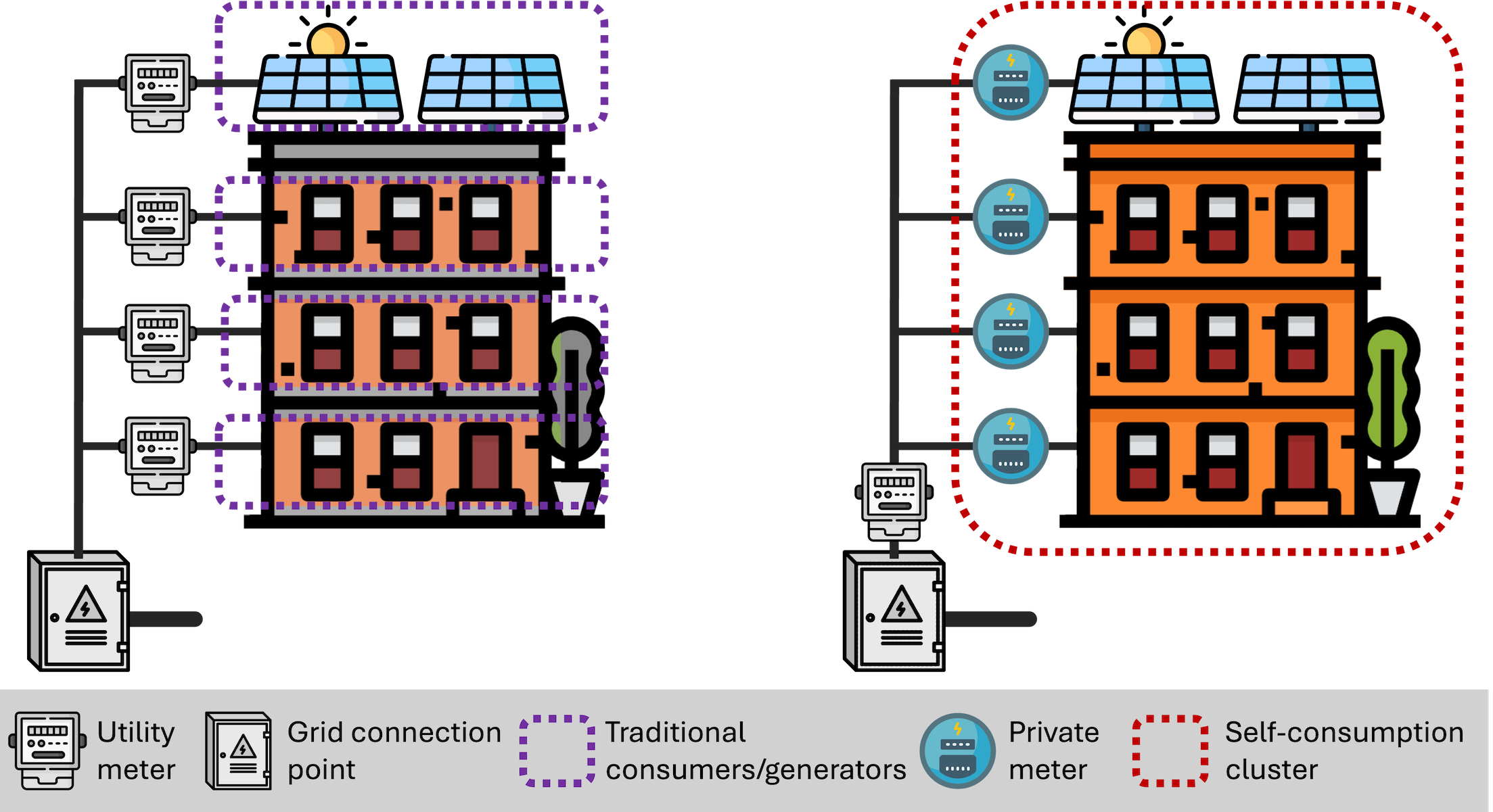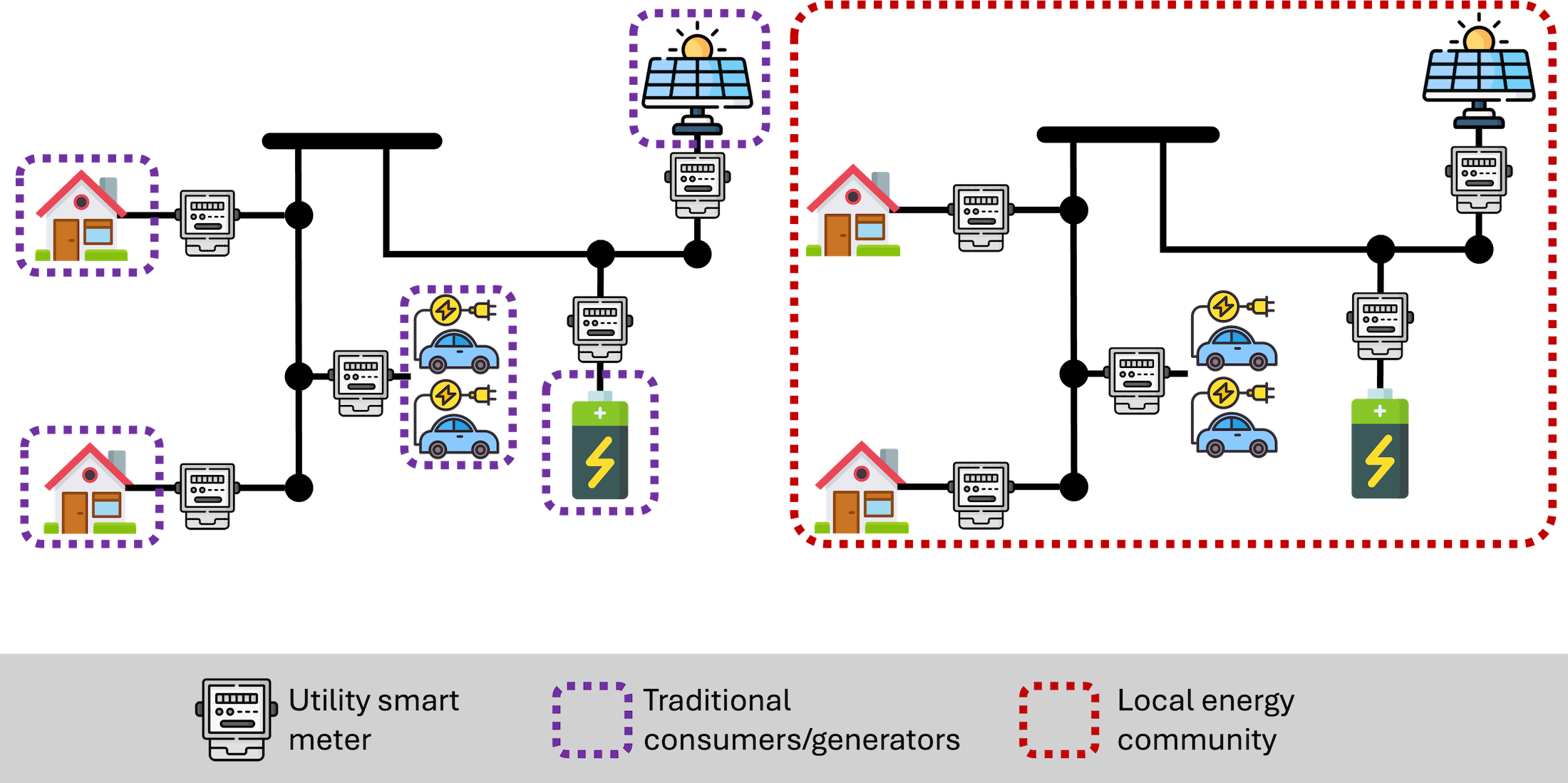Local energy communities and self-consumption clusters in Switzerland
Authors: Fabrizio Sossan, Pierre Roduit Last update: 01 March 2025
The Swiss law defines two constructs to incentivize the self-consumption of locally generated renewable electricity: self-consumption clusters (RCP, Regroupement pour la consommation propre) and local energy communities (CEL, communauté énergétique locale). These constructs differ for extension and type of connection to the power grid.
Self-consumption clusters (RCP) and virtual self-consumption clusters (vRCP)
The notion of self-consumption cluster applies to consumers and renewable generation assets connected behind a single grid connection point. In a traditional setting, each resource would have a separate meter and billing contract with the utility; self-consumption clusters make it possible for consumers to access the local renewable generation at a price directly negotiated with the generator’s owner, avoiding being billed for the retail electricity price offered by the utility. This construct applies to any renewable generation source provided that the production capacity is at least 10% of total nominal power demand and with at least 500 hours of working time per year.
Starting from January 1, 2025, self-consumption clusters extend to resources connected at different points of the grid below 1 kV, implying that the size of the cluster can be extended by using the low-voltage electrical connection of the distribution system operator. This is known as virtual self-consumption clusters.

Local energy communities
Similarly to the self-consumption clusters, local energy communities allow consumers to access cheaper local electricity by avoiding direct billing through individual utility power meters. However, while self-consumption clusters apply to consumers behind a single grid connection point (such as a building) or connected to the same low-voltage feeder, local energy communities extend to multiple grid connection points, explicitly envisaging the use of the distribution grid infrastructure, including medium-voltage, to enable the transfer of power at different locations. Local energy communities cannot extend to areas larger than a municipality; moreover, all connected consumers and producers should be on the same grid level and reasonably close to each other. The installed generation capacity should be at least 20% of the total demand.
Within the local energy community, electricity is traded according to rules and tariffs that are established internally. To account for the utilization of the grid infrastructure, distribution system operators will still apply grid tariffs, but with a cost reduction of up to 60%.

Closing remarks
Benefits for consumers and local generators
The CEL and RCP benefit electricity consumers by allowing them to access cheaper electricity, thus avoiding being billed at the retail price even when the supply comes from a nearby photovoltaic system. The concepts of CEL and RCP are also advantageous for local renewable energy producers, who can negotiate with local consumers a more profitable compensation scheme than the one proposed by the network distributor.
It is important to emphasize that the implementation of these concepts essentially involves the reorganization of power measurements for billing purposes; it does not involve changes to physical power flows nor does it require the installation of additional electrical connections.
Thanks to access to more advantageous electricity tariffs, consumers will benefit from shifting their electricity consumption to times when local renewable production is available. This shift can occur by changing consumption habits, or more effectively, through flexible loads, such as electric vehicle charging or heat pumps, which can be optimally managed by automatic systems capable of adjusting to the electricity price. Consumption shifting can also be achieved through the use of energy storage systems, such as batteries.
Challenges, Requirements and Opportunities
Developing CEL and RCP requires the ability to measure the power consumption of distributed users and producers. Many Swiss distribution network operators are currently finalizing the deployment of smart meters to make this possible.
The effective operation of CEL and RCP requires real-time coordination and control of well-designed loads and energy storage assets. This process, generally known as energy management, can be implemented through dedicated software, with varying degrees of complexity and completeness. At HES-SO Valais, we develop cutting-edge energy management systems, combining consumption and production forecasting models, numerical weather forecasts, techno-economic optimization programs, and mathematical models to ensure optimal operations of CEL and RCP.
Although legislative standards clearly open the door to the use of the local distribution network to extend the reach of RCP and CEL, the current capacity of electrical distribution networks to tolerate these new power flows should not be taken for granted. In particular, distribution networks are designed to accommodate a limited amount of renewable production and well-defined consumption levels; exceeding the design values will inevitably lead to violating the operational limits of the distribution infrastructure (line congestion, substation issues, and voltage levels outside the regulatory limits), requiring costly network reinforcements. For this reason, optimal power flow management requires the inclusion of accurate models of the electrical network to capture its limits while respecting design values. Distribution network operators, who generally have detailed knowledge of their networks, could expand their offerings to customers by providing turnkey energy management software solutions to enable the development of RCP, vRCP, and CEL in line with their operational needs.
System and grid benefits
Implementing self-consumption of locally generated electricity is advantageous because it reduces losses in power lines and cables and, if well coordinated, leads to better utilization of the power distribution grids, with less congestions and improved voltage levels.
For more information
If you are interested to learn more or discuss developments, contact the authors.
References
- AES (seen on 2024), Réglementation de la consommation propre
- Definition of self consumption clusters (2025), Law 730.01
- Introduction of local energy communities (2024), Atto mantello RU 2024 679
- Le Conseil fédéral met en vigueur le deuxième volet de la loi fédérale pour un approvisionnement en électricité sûr [Link] (https://www.admin.ch/gov/fr/accueil/documentation/communiques.msg-id-104172.html)